
How healthy is your neighborhood?
A new way to understand urban well-being
Cities are more than just buildings. They shape how we live, feel, and connect. A healthy city offers clean air, safe transportation, green spaces, and opportunities for social interaction. Yet, as urban areas expand, these qualities come under pressure.
By 2050, nearly 70% of the world’s population will live in cities, facing increased noise, pollution, inequality, and stress.

Improve health
To address these challenges, the municipality of Eindhoven launched the Healthy Living Area project, aiming to improve health in neighborhoods. However, they encountered a key obstacle: existing tools focused either on hard data or personal experiences — rarely both. What was needed was a method that could integrate objective indicators with the lived experiences of residents.
In collaboration with the municipality, Eindhoven Engine hosted the EngD project of Golnoosh Sabahifard, embodying its core philosophy: deeply understand the problem before jumping to solutions. A systems overview was essential, beginning with a systems dynamics sketch — the foundation for a model that could later support policy scenarios. Crucially, the project wasn’t done for the people, but with them. Stakeholders were involved in co-creating and validating the systems map, ensuring it reflected real experiences. These principles — co-creation, systems thinking, and problem understanding — are central to Eindhoven Engine’s approach to innovative solutions.
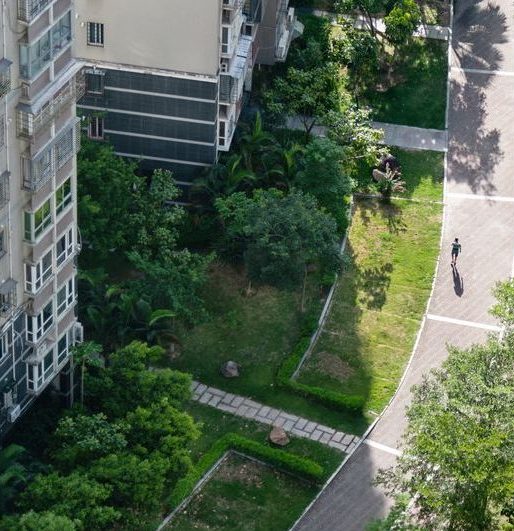
A new approach: Combining data with daily life
With a background in architecture and built environment, Golnoosh brought a systems-thinking mindset to the project. She combined systems dynamics modeling with citizen participation, using the Vensim platform to build a model based on eight criteria — four social and four environmental — already used by the municipality:
Social indicators:
- Socioeconomic status (SES)
- Loneliness
- Stress
- Years in good perceived health
Environmental indicators:
- Green space
- Noise levels
- Distance to facilities
- Population density
These criteria were applied to two neighborhoods: Hemelrijken and Blixembosch-Oost. The model visualized how these factors interact, enabling comparison and scenario testing. But numbers alone weren’t enough. To capture residents’ perspectives, Golnoosh used the Repertory Grid technique. Participants compared criteria in triads — for example, stress, green space, and noise — and explained which two felt similar and why. This revealed personal constructs like “quiet vs noisy” or “stressful vs calm.” Residents then rated all criteria, adding depth and nuance to the model.
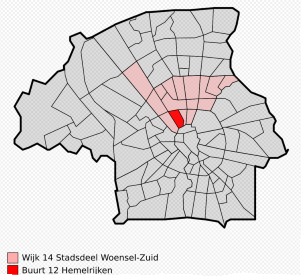
Neighborhood-specific strategy
The findings were revealing. In Hemelrijken, low SES and high stress emerged as the strongest negative drivers of health. Green space and noise were key environmental concerns. Residents confirmed these insights, emphasizing stress, noise, and crowding as major issues. They prioritized solutions such as stress relief, affordable housing, and long-term health support.
In contrast, Blixembosch-Oost presented a different picture. Residents focused more on long-term health, SES, and green space. Loneliness and distance to facilities were more prominent concerns, reflecting the suburban layout. While noise and stress were present, they weren’t central. Residents valued green space and lifestyle health, viewing affordability and density as moderate issues.

These differences highlight a crucial lesson: urban health strategies must be neighborhood-specific. What works in one area may not apply in another. A one-size-fits-all approach simply doesn’t work.
Based on the findings, Golnoosh proposed tailored solutions:
- For Hemelrijken: pocket parks, green roofs, noise reduction measures, affordable housing, and community events to relieve stress and foster belonging
- For Blixembosch-Oost: preserving green infrastructure, health awareness programs, noise buffers, and inclusive community activities
Two additional insights emerged. First, urban health is shaped not just by data, but by people’s lived experiences. Residents often described health in personal terms, such as ‘quiet vs noisy’ or ‘stressful vs calm’. Second, co-creation is essential: involving residents leads to more grounded and accepted solutions.
Finding solutions is easy — once you truly understand the problem.
The next phase
The project didn’t end there. A new team member, Veron Afonso, joined to expand the systems dynamics simulation, bringing an IT perspective. The next phase involves returning to residents for validation and scenario building, continuing the cycle of co-creation and refinement.
This project exemplifies how diverse expertise, citizen involvement, and systems thinking can lead to meaningful urban innovation. As Golnoosh’s work shows, understanding the problem deeply is the key to designing healthier cities. Once the real challenges are clear, solutions follow naturally.

Media: Mijke the Matchbot guides you through the jungle of social organisations
Imagine you have a question about finances, your health, or a difficult letter. But in the maze of social organisations, your first attempt always leads you to the wrong organization. For over three million Dutch people with limited basic skills, this is a daily reality. Many give up out of frustration or shame. Mijke the Matchbot aims to change that: a friendly digital assistant, developed with support from the Regio Deal Brainport Eindhoven funds, that actually points you in the right direction.
Source: Brainport Eindhoven

Advancing energy flexibility in buildings
Transforming building energy management with smart control systems
The BuildInFlexergy project, funded by the Dutch Mission-Driven Research, Development, and Innovation (MOOI) program, is revolutionizing building energy flexibility. This is supported by the Dutch Ministry of Economic Affairs and Climate Policy and the Ministry of the Interior and Kingdom Relations, and managed by the Netherlands Enterprise Agency (RVO). This four-year industry leading initiative unites 10 industry partners (including Eindhoven Engine) and 2 top universities (TU Eindhoven and TU Delft).
A unified approach to innovation
Coordinated and managed by Kropman B.V., the consortium includes installation companies, energy consultants, platform developers, building owners and managers, technology providers, and other experts. The aim is to foster open knowledge exchange and drive innovation through strategic collaboration and widespread dissemination of results.
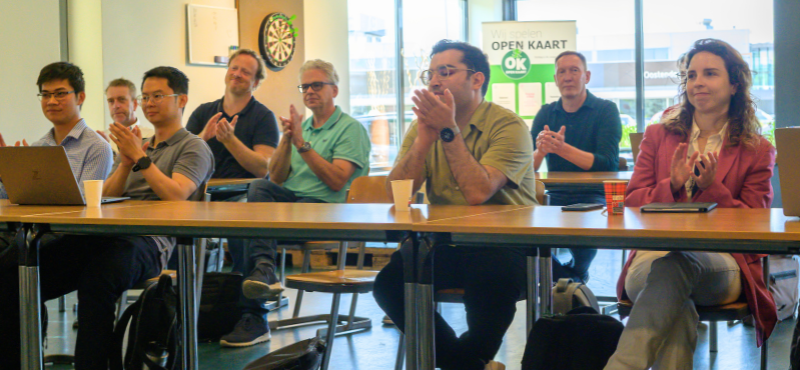
Buildings at the heart of the energy transition
As the energy sector shifts towards a decentralized, digital, and low-carbon future, buildings—significant consumers of electricity and thermal energy—are key to providing demand-side flexibility. This flexibility allows buildings to adjust their energy use in response to external signals like electricity prices, carbon intensity, or grid constraints, without sacrificing occupant comfort or essential functions.
Kick-off meeting 17th June, 2025 | Kropman Nijmegen
The power of model predictive control
Model Predictive Control (MPC) is a cutting-edge tool for optimizing building energy performance. Unlike traditional control systems, MPC uses predictive models and real-time data to proactively manage a wide range of systems, including HVAC (Heating, Ventilation, and Air Conditioning), lighting, heat pumps, thermal storage, electric vehicles charging and other building loads It uses forecasts of occupancy, weather conditions and other relevant parameters to determine the best control actions over a future period, continuously updating the plan based on new data.
The aim of this project is to foster open knowledge exchange and drive innovation through strategic collaboration and widespread dissemination of results.

Real-time responsiveness with dynamic climate control
Dynamic climate control adjusts HVAC settings and ventilation rates based on changing indoor and outdoor conditions. This allows buildings to pre-cool or pre-heat spaces when renewable energy is plentiful or electricity prices are low, shifting loads without compromising comfort or overloading the grid.
Optimizing with key performance indicators
Key Performance Indicators (KPIs) are developed based on the Smart Readiness Indicator. KPIs guide decisions and balance objectives like energy cost, comfort, CO₂ emissions, and grid support. KPIs such as total energy consumption, peak load reduction, indoor comfort indices, and flexibility scores can be prioritized based on goals.
The future of building energy flexibility
The KPI-driven MPC framework makes buildings energy-efficient, grid-responsive, and climate-conscious. This approach is ideal for buildings in smart grids or demand response programs, supporting both building managers’ operational goals and energy system planners’ strategic targets.
In conclusion, combining MPC, dynamic climate control, and KPI-driven optimization can significantly enhance building energy flexibility. This strategy is crucial for making buildings active participants in the low-carbon energy system of the future.
Eindhoven Engine News – June 2025
In this edition of Eindhoven Engine News: Oefenen.nl and Eindhoven Engine join forces, Workshop ‘The Power of Understanding Each Other’, EngD trainee Sichen Guo in the spotlight & more
What else is happening at Eindhoven Engine?

Tackling energy challenges in buildings
The BuildInFlexergy approach
As buildings become increasingly reliant on electricity to maintain their indoor climate, they face challenges such as electricity supply and limited grid capacity.
To address these issues, Eindhoven Engine is happy to announce the BuildInFlexergy initiative commenced on May 1st, 2025.
Focus on energy flexibility
This project brings together 12 partners, including Eindhoven Engine. It aims to enhance the reliability and efficiency of local energy supply by better utilizing energy flexibility. Additionally, this initiative is particularly crucial for large, complex building systems equipped with heat pumps and thermal energy storage. These systems often experience stability and coordination issues, which can negatively impact both energy and comfort performance. Therefore, by focusing on energy flexibility, BuildInFlexergy aims to overcome these challenges and ensure a more stable and efficient energy supply for building.
Smart control systems and model predictive control
By transforming building energy management with smart control systems and model predictive control, we achieve real-time responsiveness and dynamic climate control. Moreover, this optimization uses key performance indicators. This unified approach to innovation places buildings at the heart of the energy transition, paving the way for the future of building energy flexibility.
This project not only addresses current challenges but also sets a precedent for future developments in energy-efficient building management.

Mijke the Matchbot: Bridging gaps with AI
Introducing Mijke, the Matchbot: a conversational AI designed to bridge the gap between individuals with low literacy and the support systems around them.
Hi, I’m Sichen, and I am currently pursuing an Engineering Doctorate (EngD) at Eindhoven Engine. With a background in Industrial Design and a strong focus on user experience (UX) and interaction design, I completed my master’s at Eindhoven University of Technology.
Currently, I work within the focus area of Inclusive Society. Here, I explore how AI can create more accessible and supportive environments for everyone. Our solution? Mijke, the Matchbot.
Breaking barriers with AI
My EngD project focuses on the development of Mijke from the Met Mij project. Mijke is a conversational AI chatbot designed to support NT1 (Dutch as a first language) adults with limited basic skills in accessing local services. Hosted on WhatsApp and powered by a large language model, Mijke offers both voice and text interaction. This reduces the barriers many users face with written communication.
The project explores five core challenges:
1. Clarity in communication
Ensuring the chatbot communicates clearly.
2. Emotional connection
Providing a supportive and empathetic interaction.
3. User-friendly design
Making the chatbot intuitive and user-friendly.
4. Multi-modal accessibility
Offering multiple modes of interaction.
5. Precision in support
Connecting users with the right help efficiently.
For more information about Mijke and the Met Mij project.
Addressing information inequality
Millions of people in the Netherlands struggle with basic literacy, numeracy, and digital skills. Mijke shows a possibility of solving this information inequality by offering a friendly experience tailored to the real-world needs of often overlooked people via Artificial Intelligence (AI). This work stands at the crossroads of technology, social equity, and public service innovation. It shows how AI can be used responsibly in human-centered design.

Empowering communities
To achieve these goals, I plan to run iterative user tests to gather insights and improve mijke’s usability. to help people with limited basic skills access support more easily and confidently. By doing so, I hope to decrease the workload of stakeholders, such as social workers, employees from municipalities, or public service staff. Additionally, I want to set a benchmark for evaluating AI recommendations in social public service contexts and contribute new knowledge and tools to the fields of human-computer interaction (HCI), accessibility, and digital inclusion.
This work stands at the crossroads of technology, social equity, and public service innovation, showing how AI can be used responsibly in human-centered design.
Media: Laaggeletterdheid aanpakken: Oefenen.nl en Eindhoven Engine slaan handen ineen
On Tuesday, May 13, Stichting Expertisecentrum Oefenen.nl and Eindhoven Engine signed a cooperation agreement with a joint mission to make clever use of digital technology to reduce the gap between people with limited basic skills and society.
Read the Dutch article in Eindhovens Dagblad.
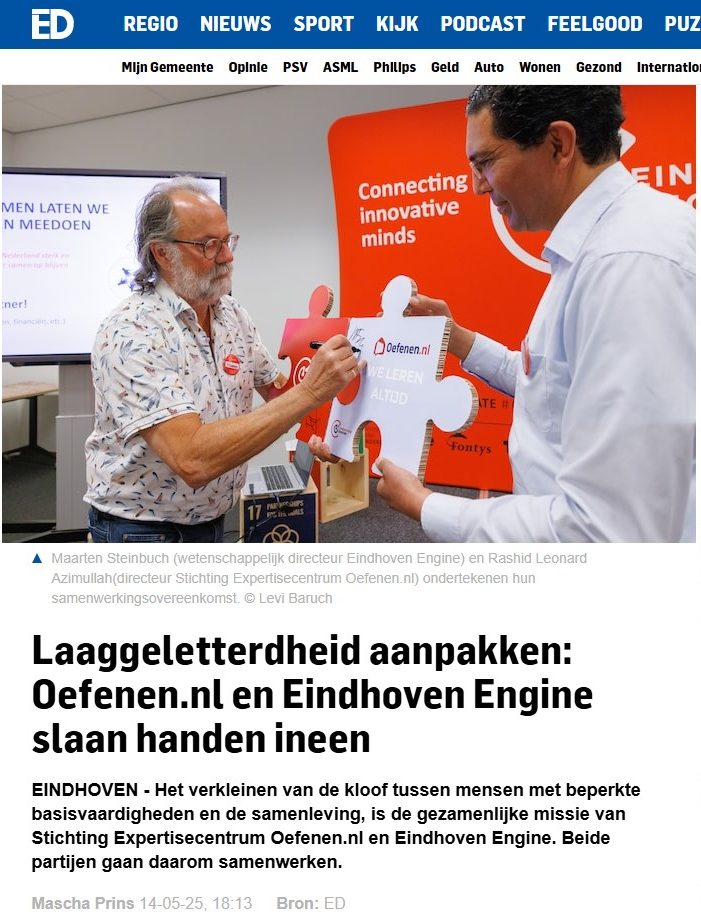

Oefenen.nl and Eindhoven Engine Digital join forces to use digital technology to bridge the gap in basic skills
On Tuesday, May 13, Stichting Expertisecentrum Oefenen.nl and Eindhoven Engine signed a cooperation agreement with a joint mission to make clever use of digital technology to reduce the gap between people with limited basic skills and society.
Challenges for people with limited skills
Currently, millions of young adults in the Netherlands experience difficulty with language, numeracy and/or digital skills. This results in distressing situations, like not being able to understand letters from the bank or not being able to make an appointment with the doctor because it has to be done digitally. Such situations lead to all sorts of negative personal and social consequences, such as living too long with a medical complaint or incurring unnecessary extra costs due to an increase in bank fees, simply because you don’t want or dare to ask for help. With the rapid emergence of technological developments such as AI, this group threatens to fall even further behind.
Although many people are motivated to learn, they tend to seek accessible and practical ways of doing so outside formal education. It is precisely this non-formal provision that is still underinvested, also when it comes to technological innovation.
This is a great milestone and only the beginning. We aim to expand our collaboration with more partners. The more support, the faster we can extend our reach.

Purpose of the cooperation
Stichting Expertisecentrum Oefenen.nl and Eindhoven Engine want to change that. Together, they will update and enhance the learning platform Oefenen.nl with technologies such as artificial intelligence, gamification and smart onboarding. The goal: to make learning more motivating and accessible, so that everyone can work on their language, numeracy and digital skills at their own pace and level.
Powerful combination of knowledge and reach
The cooperation is based on their complementary expertise. Successful participation in Dutch Design Week 2024 and reaching the semi-finals of an innovation award in November 2024 can both be attributed in part to: over 30 projects involving 57 students from TU/e, Fontys and Avans, two EngD trainees working on applying academic research in society and industry, and 150+ hours of co-creation with experience experts. Eindhoven Engine demonstrates how education, technology and social impact go hand in hand, bringing technological expertise, innovative strength and access to the Brainport network.
The gap in basic skills is growing and that demands action. With the reach of Oefenen.nl and the technological innovation power of Eindhoven Engine, we are building a bridge to the future.
Oefenen.nl offers a learning platform that has a proven reach to the target group. In 2024, more than 65,000 participants actively used the Oefenen.nl programs. The platform was visited over 1.45 million times that year and more than 35,000 certificates were awarded. Oefenen.nl works with 400 organizations throughout the Netherlands, including libraries, municipalities and educational institutions, which use its resources to support people in developing their language, numeracy, financial and digital skills. Together, the organizations aim to ensure that the learning experience of users is radically improved and the impact on society is boosted.
Call to industry and knowledge institutions
To make a real difference, Oefenen.nl and Eindhoven Engine are calling on other parties to get involved. Industry, knowledge institutions and government bodies can contribute through donations, co-development or knowledge sharing.
Only by working together can we ensure that no one is left behind and that everyone can participate fully in our digital society.
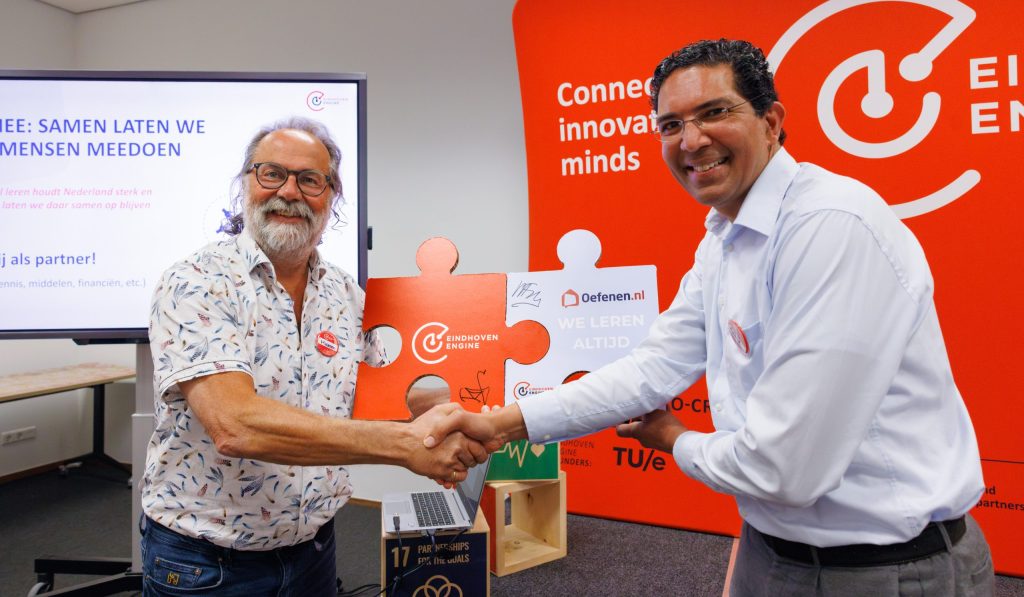
Eindhoven Engine present at the Slim Samenleven Dagen 2025
We were proud to showcase Mijke the Matchbot, our latest innovation during the Slim Samenleven Dagen 2025 in Den Bosch last weekend!
Mijke is an AI matchbot that guides individuals to the right help, making support more accessible and personalized. It helps them to stay active, healthy, and connected in an increasingly digital world — exactly the kind of challenge this event aimed to address.

Brabants Dagblad
And yes — we even made it into the Brabants Dagblad! (Though the title “Weinig publiek voor ouder worden met slimmigheidjes” made us chuckle … we had inspiring conversations, made meaningful new connections, and raised awareness around a complex societal challenge: the lack of basic skills.
We’re grateful for the exposure and proud to be part of the movement toward smarter, more inclusive living — for everyone, at every age.
- More about Mijke the Matchbot and/or Inclusive Society
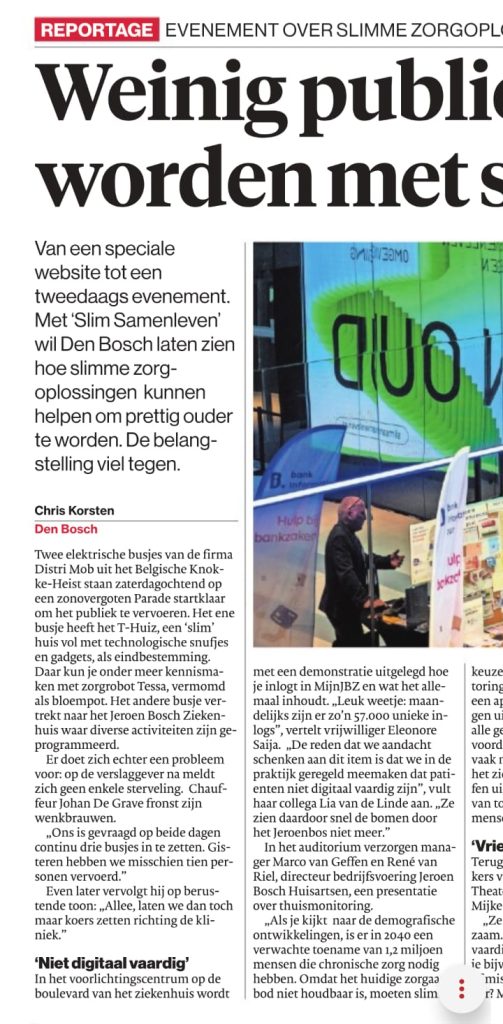

Eindhoven Engine News – March 2025
In this edition of Eindhoven Engine News: Innovation accelerator Eindhoven Engine enters new phase, Transforming basic skills support with AI and more!
What else is happening at Eindhoven Engine?
